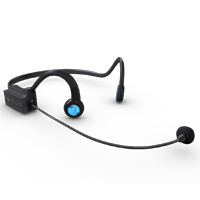Forbrain

| Ages: | kids (+3 years old) teenager and adults |
| Price: | $359 |
| Website: | www.forbrain.com |
| Year: | 2015 |

Forbrain is an innovative device that improves auditory and sensory processing by retraining the brain. Based on years of research in neuroscience and the auditory process, this easy-to-use device has the potential to help children and adults who suffer from speech and language difficulties, as well as aid in the improvement of attention, memory and sensory stimulation.
The Device
Forbrain features a headset with a microphone and dynamic filter. The core concept of the device is the use of bone conduction to transmit sound. There are two ways of processing sounds. The most common way is through the ears. Typically, sound waves conveyed through the air pass through the ear and are converted into nerve impulses that go to the brain where they are processed. In bone conduction, sound is passed through the bones, and eventually to the brain via the auditory nerve.
There are several advantages to bone conduction. First, sound travels about ten times faster through the bones than the ears. Secondly, the sound is much clearer and not interfered with by other extraneous noise. Bone conduction thus transmits sounds more efficiently.
The dynamic filter has a number of functions. First, it reduces low acoustic frequencies, adding to the clarity of the sound fed back to the users. Second, by varying the acoustic frequencies, the filter demands more attention from the brain as it has to constantly adjust to these changes in sensory input. The brain is stimulated by change and by varying the frequencies through the dynamic filter the brain is more engaged and attentive. The combination of bone conduction and the dynamic filter therefore retrains the brain, sharpening its focus to auditory input in particular, sensory stimulation in general and improving attention.
This unique technology helps with a number of different problems. The acquisition of language and the development of speech are critical for communication of all types including reading and writing. Problems with language and speech development are typically not to do with the physical aspects of the ear or hearing but the ability of the brain to decipher the different sounds and parts of speech. Enhancing the brain’s attention through the dynamic filter and improving clarity through bone conduction make it easier for users to understand the spoken word.
In addition, the clarity afforded by bone conduction makes it easier for the user to hear his or her own voice. A complex feedback loop regulates a person’s speech and this loop is sharpened and improved through the Forbrain technology. This teaches the user to speak more clearly. This has the added benefit of increasing confidence and self-esteem as well as speech clarity.
Because sound is implicated in about 70% of all sensory input, improving auditory processing is likely to have a generally positive effect on all sensory processing.
Validity of Sound Processing
The notion that improving sound processing can have widespread benefits is an accepted fact.
Doctor Carles Escera, a cognitive neuroscience specialist, director of the Institute for the Brain, Cognition and Behavior at the University of Barcelona has reviewed Forbrain and writes on existing research that…
“Studies reveal that the encoding of sound properties in the auditory system can be modified by different forms of training; this is particularly relevant because, as shown in some of the studies, these training programs can ameliorate deficits in several pathological conditions, such as in dyslexia, learning disabilities, autism spectrum disorders or the consequences of normal aging on speech-in-noise perception.”
Attention and Memory
As is mentioned above, the variations created by the dynamic filter force the brain to be more attentive. So, as well as helping with language acquisition and speech production, Forbrain can improve attention leading to benefits for those with attention difficulties. Again, Professor Escera writes:
“The brain needs to learn to cope with and to filter out these random variations created by the dynamic filter in what can be regarded as a training exercise for the executive control of attention.”
Because Forbrain increases attention it also enhances memory. The clearer a sensory signal and the better the attention, the more accurately such sensory signals will be encoded in memory. Think of the difference between trying to process and remember a garbled sound compared to a very clear one.
Ease of Use
One of the values of Forbrain is that it can be used anywhere. Although many speech therapists and other practitioners around the world use it, the device is non-invasive and can easily be used at home and without a healthcare professional present. It is easy and fun to use and doesn’t require a big investment of time or money. The recommended time of use varies from five to twenty minutes a day depending on the age of the user and the purpose of use. Because the device is portable, easy to operate and doesn’t need the presence of a professional or any expenditures outside of the initial purchase, users tend to continue using it to good effect.
Users are encouraged to sit up straight, relax and breathe calmly. There are various ways adults can help children using the device. They can read along with the child. accompanying him to demonstrate the correct language skills, or sing along to emphasize musicality and correct intonation and rhythm. Adults can also echo the user’s responses and they can emphasize diction and accentuation.
Research
Formal research studies are now taking place at the University of Barcelona and elsewhere. To date, we have many, many testimonials and case histories from around the world that attest to Forbrain’s usefulness. Parents, users, health professionals and teachers have all commented on Forbrain’s efficacy.
For example, a teacher and school director wrote, “I introduced Forbrain in our school four weeks ago. I have seen already good results with my students, especially in reading. The kids are practicing all together and they enjoy it a lot. I can’t wait to see how far we could go with this tool!!”
A SIPT certified occupational therapist, working for years with several different programs such as sensory integration programs, DIR /Floortime and listening programs says that “Forbrain has made a huge difference to my clients!”
A teenager with ADHD says, “Forbrain is just amazing! I have always had a hard time completing my work and paying attention but with Forbrain that has changed. For the first time I can remember all my lessons and complete my homework!”
Another speech and language therapist says, “I recently discovered Forbrain and tried it with some patients during our working sessions. They are doing their exercises with it and they love it. They really appreciate the clarity of the feedback of their voices. They all reported that using Forbrain makes it easier doing their work. I strongly recommend Forbrain.”
One mother says: “I wanted to tell you that I’ve been using Forbrain for several days with my 6-year-old son during his reading time. He’s made a ton of improvement in articulation and fluency, and even his teacher commented on it. He is also much more self-confident and motivated to read his pages at night.”
Summary
Forbrain is an innovative device based on established principles of auditory processing. Using bone conduction and a dynamic filter to retrain the audio-vocal loop, users can improve their auditory processing, specifically their awareness of different parts of speech. Forbrain also allows for better sound discrimination and acoustic integration of user’s own voices. Through the innovative technology of the dynamic filter, attention and memory can also be improved. The device is very low maintenance and can be used anywhere.
